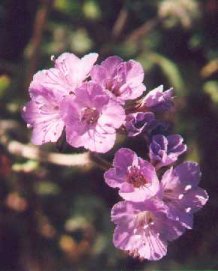|
 SCORPION WEED - Phacelia sp. Miltitzia sp. Bueschelblume, Phacelia, Phacelie, Phlox, Scorpionweed, Wild
Heliotrope. Russian: Fatseliya. Some species are also called Caterpillar Weed. The reason for the name is because
the flowerhead curls around like the tail of a scorpion. The flowerheads of some of these plants resemble Fiddleneck,
but they have purple, blue, or white flowers instead of orange. Contact with species having glandular pubescence,
such as this one, causes dermatitis.
SCORPION WEED - Phacelia sp. Miltitzia sp. Bueschelblume, Phacelia, Phacelie, Phlox, Scorpionweed, Wild
Heliotrope. Russian: Fatseliya. Some species are also called Caterpillar Weed. The reason for the name is because
the flowerhead curls around like the tail of a scorpion. The flowerheads of some of these plants resemble Fiddleneck,
but they have purple, blue, or white flowers instead of orange. Contact with species having glandular pubescence,
such as this one, causes dermatitis.
P. bombycina. Wild Heliotrope, a false designation. True wild heloptrope smells better and has flowers pale to
white in color.
P. campanularia (P. minor, whitlavia, Whitlavia m., grandiflora): California Blue
Bell, Desert Bell, Wild Canterbury Bell. This ornamental has intense blue flowers.
P. congesta: Tomasita. This ornamental has lavender flowers.
P. coerulea (P. crenulata, ambigua, corrugata, invenusta, minutiflora): Heliotrope
Phacelia, Wild Heliotrope. Seri: Cahaahazxot ctam "male desert marigold", Najmis. This species has an unpleasant
odor resembling onion.
P. grandiflora (Eutoca g., speciosa). The flowers of this ornamental are lavender
with violet veins.
P. integrifolia (P. palmeri, douglasii, stellaris, E. d.): Palmer Phacelia,
Scalloped Phacelia. Dine: Azeentchiiitshoh "big medicine that irritates the skin".

P. magellanica (P. heterophylla, mutabilis, nemoralis, virgata, californica, imbricata,
hastata, leucophylla, leptosepala, frigida, compacta, dasyphylla): California Phacelia, Changeable
Phacelia, Purple Fiddleneck, Rock Phacelia, Shade Phacelia, Silverleaf Phacelia, Varileaf Phacelia, Virgate
Phacelia, Whiteleaf Phacelia, Woodland Phacelia. Kashaya: Thunkuhtu. Kawaiisu: Tuhukidibi "black", Tuhkwidi
tinaagadi "having a black root". The roots gathered in summer may be stored three years. Diuretic. The decoction
is drunk warm for weakness and upset stomach, coughs and colds. The fresh leaves are crushed and the juice rubbed
in cold sores or impetigo. The flowers attract bees. It is an ornamental.
P. ramosissima (P. decumbens, suffrutescens, bifurca, polystachya, hispida, eximia, cicutaria,
heterosepala, tanacetifolia, cryptantha, eremica, distans, scabrella, arthurii, arthuri, leptostachya, commixta,
umbrosa, ammophila): subsinuata, cinerea): Branched Phacelia, Branching Phacelia, Caterpillar Phacelia,
Common Phacelia, Fern Phacelia, Fiddle Neck, Wild Heliotrope. Kawaiisu: Yuhwitibi, Yugwitibi, Sawidoovi. The stem
and leaves are gathered in the spring before the flowers appear. Lay them on a flat rock and put hot rocks on top,
and then more plant. Sprinkle water on the rocks to steam them. Put on more hot rocks as needed. The leaves can be
prepared more traditionally as spring greens. They can be boiled. The boiled root yields a liquid drunk for
gonorrhea. Emetic. It is supposed to be a treatment for the stomach problems that accompany gonorrhea.
P. viscida (E. viscida): Musgrave, is grown for its blue flowers.
Nemophila sp. Hainblume, Nemophila, Nemophile. Russian: Nemofila.
N. menziesii (N. insignis, atomaria): Baby Blue Eyes, Pale Baby Blue Eyes. This
is an ornamental with light blue flowers.


|

